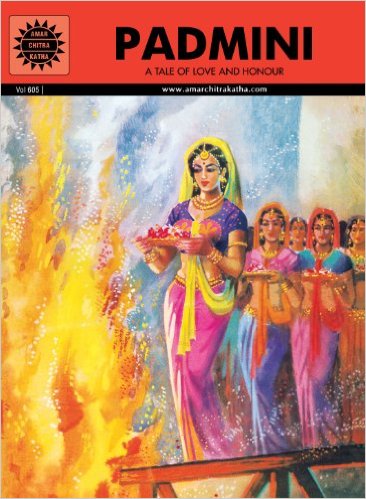Pushpendra Johar
Cinema, sexuality and conflict seem closely linked given the kind of commodification the former enables for the latter two. Though, what is almost never discussed is the over-determining factor that guides all these three – caste. As events have unravelled in the past few days with news of a regressive1 and celebrated bollywood filmmaker getting roughed up at the hands of the members of a retrograde caste-based organisation, there has been some conversation around the mythical queen of Chittor, Rani Padmavati’s (aka Padmini) story, and the facts of falsity therein. The arguments by social media users, researchers, and media persons – all reacting from their caste locations – inform us that Padmavati has graduated from myth to legend to history – the process of actualization of the idea of Padmavati.

Why is someone making a film on a mythological character and why a caste based group is contesting the sexuality of such a figure? Both these questions need to be explored in the context of the two stakeholders in focus.
It’s a fight for ‘honour’, the Rajput Karni Sena and its supporters have been saying2. But before we go ahead it is important to distinguish between honour and caste-pride. Both of these are being used interchangeably in such contexts where communities invoke their pasts and use them to impose their caste supremacy on the marginalised castes. The upholders of Padmavati’s on-screen chastity are actually upholding their own patriarchal positions and caste-pride.
How is such caste-pride created and nurtured? The inherent nature of the caste system informs that hegemony is the sole purpose, for which violence of multiple kinds is put to use. Violence exists in various forms, from being encoded in the scriptures to everyday language, in interpersonal interactions and even in the myths and legends. It is further perpetuated through hegemonic social processes. In a caste society there are multiple factors at play with a single aim of subordinating people. The process of inflicting violence became more organised when the Indian state was constituted. It is unfair to refer to the state as simply Indian, for it needs to be located within its primary identity – caste. There has been no ambiguity on the part of its functionaries to assert that it is a brahmin-savarna state. In order to establish its caste at a ‘national’ level its brahmin-savarna knowledge appropriators3 have worked continuously to reproduce and perpetuate caste through vulgar myths and legends.
Padmavati’s story follows the same structure and function. It is one such imagination which was used to construct two important aspects in the social life of the newly constituted nation: the imposition of a regressive myth on the society as a whole through a moral order guided primarily by caste superiority. Additionally, the idea of the chaste upper caste woman4 whose sexuality her caste-men could be proud of became a means for reproducing and imposing patriarchy in its worst form where the woman is expected to kill herself to keep the honour of her caste intact. Many dalit-bahujan men and women have been fighting sexual aggression by the same upper caste people for centuries now but those stories do not qualify to be national legends for that will turn the whole purpose of creating a Padmavati story upside down.
Much has been written about the construction of the ‘muslim other’ by the fascist forces. However, what the savarna-dominated intelligentsia does not acknowledge is that the shift from lodis to mughals to british to brahmin-savarna nationalists was a continuity of power hierarchy5. Being decadent royals, Mughals never represented the Muslim masses. The only people who can still boast of mughal pride are the elite Muslim zats in both India and Pakistan. The british had focussed goals around business expansion coupled with proselytization. They seized resources and would cleverly take decisions which promised them maximum returns. They did not meddle with the social system beyond their necessity which also got translated into the political sphere. With the formation of union of India (later Republic of India) the power got transferred in the hands of a handful of brahmin-savarna castes who have since then been projecting their interests through various ways of knowledge appropriation. The need for myth construction was almost contingent at this point for the Indian state to create a story where the upper caste men and women upheld the rule of dharma. One doesn’t need to be trained in anthropology to observe that almost all the communities throughout the world develop their own myths and legends. These myths serve multiple functions apart from informing the myth makers and myth-carriers about their socially coded information.
Myth making is not divorced from power hierarchy that is an inherent feature of the caste society. The kind of injunctions that the brahmin-savarna Indian nationalists chose to impose upon the people of India was concocted by the knowledge appropriators and formalized through school textbooks and other forms of media such as Amar Chitra Katha comics. Padmavati story’s ‘upgradation’ to history was a major step in that direction. It referred to the value of killing oneself in fire as superior over defiance of many dalit-bahujan men and women who have not just fought sexual aggression at their hands but have also fought and withstood physical violence in many other forms. How does it get omitted from the arguments put forth vis-a-vis the current controversy that the caste group which is fighting amongst themselves to preserve the honour of a mythical rajput queen have a reputation for committing crimes against dalit-bahujans almost regularly? How is that inequality tolerated by the same ‘unbiased’ intelligentsia and media?
What gets missed in the whole cacophony is that Sanjay Leela Bhansali (SLB) and Rajput Karni Sena represent similar caste interests. On one hand SLB is focused on consolidating and realigning the rajput caste glory through digital projections. This time around Padmavati’s story is tailored and presented for the culture-hungry, global, liberal yet proud caste hindus, who want to have a connect with their glorious past. In order to reinforce the racial stereotype of a rajput queen and the supposedly complementary relationship of race and caste, Padmavati is embodied in none other than a gaur saraswat brahmin actor Deepika Padukone. Her rise to becoming a superstar cannot be delinked from the way bollywood has kept the caste consciousness alive by employing actors from a specific caste and regional milieu.
Rajput Karni Sena, on the other hand seems worried about letting go of the feudal control of Rajasthani villages and towns, if they don’t assert their claim over supposedly de-sexualised and popularised construct of Padmavati. The idea of Padmavati swings between two distinct yet continuous patriarchal positions, trying to define that idea as per their needs. One does it in the name of artistic expression/freedom, whereas the other attempts physical violence in the name of protecting the honour of their caste by deep-freezing the fictitious sexuality of a fictitious person. Both rajputs, both powerful, both stinkingly patriarchal; and both driven by the idea of perpetuating hegemony.
The difference between SLB inc. and the Rajput Karni Sena lies in the kind of immediate material realities they are part of. SLB is in the thick of the bollywood milieu which boasts of its secular and liberal credentials by citing examples of its guild members who come from pathan, ashraf, khatri, brahmin (from possibly all parts of India), rajput, baniya, kayastha backgrounds. The industry has to stay relevant to the city-bred money wielding savarna castes by portraying ‘secular’, ‘liberal’ and seemingly modern protagonists even if the film were set in the neolithic period. With the changing contexts and capital flow the characters of the bollywood films have found themselves being a little more sexually expressive on screen. Sexual overtness coupled with romance is one of the essential ingredients for most of the bollywood productions. Thus Padmavati, as scripted by SLB, needs to be glamorised in order to further contemporary bollywood sensibilities, something the Rajput Karni Sena considers audacious.
The idea of Padmavati is the point of connection for both the rajput stakeholders: Bhansali and Rajput Karni Sena. Both react primarily from utterly casteist and patriarchal standpoints trying to keep caste intact through its reformation, glorification and commoditization in one case and through coercion, physical violence and feudal might in the other. Myths like Padmavati have multifold purposes. They perpetuate caste violence not just in an epistemic sense but also justify crimes like honour killing, female foeticide and may also lead to the resurgence of barbaric practices like sati as was reported from Rajasthan a few decades ago6.
The conflict tumbling out of our tv and computer screens and newspaper columns is a story similar to BORI’s7 kauravas and pandavas fighting for and against restoring dharma and as usual at the cost of millions of dalit-bahujans and their pride. There aren’t any contradictions in their conflict, for both are fighting for the same goal – to preserve the caste order.
~
Notes
1. Refer to films like Devdas, Hum Dil De Chuke Sanam, Bajirao Mastani and Goliyon Ki Raasleela Ram-Leela. The constant themes that run along all these films glorify certain castes, fix gender roles and justify gender violence.
3. For more discussion on this see “Hatred in the Belly” published by The Shared Mirror. 2015. Hyderabad
4. For more discussion on this see “Pitting Love against Love, the Hindu Moral Code on Sex and Sexuality” by Hari Prasad on RoundTableIndia.co.in
5. There is umpteen data through which this can be demonstrated. But even if one cursorily examines the major domains like judiciary, civil services, industries, academic spaces, media etcetera, it comes out quite starkly that all these spaces have been dominated by the brahmin-savarna class since the time Indian nation came into being and that trend continues till date.
6.http://indiatoday.intoday.in/story/sati-roop-kanwar-was-cheered-as-she-burnt-on-her-husbands-pyre-now-shes-a-faint-memory/1/254755.html
7. The Bhandarkar Oriental Research Institute is a pune based public organisation, owned and run by marathi brahmins. Their ongoing mega research project is on Mahabharata.
~~~
Pushpendra Johar ( joharpushp@gmail.com) is a doctoral student at the Department of Anthropology, University of Delhi.
Image Courtesy: The Internet










